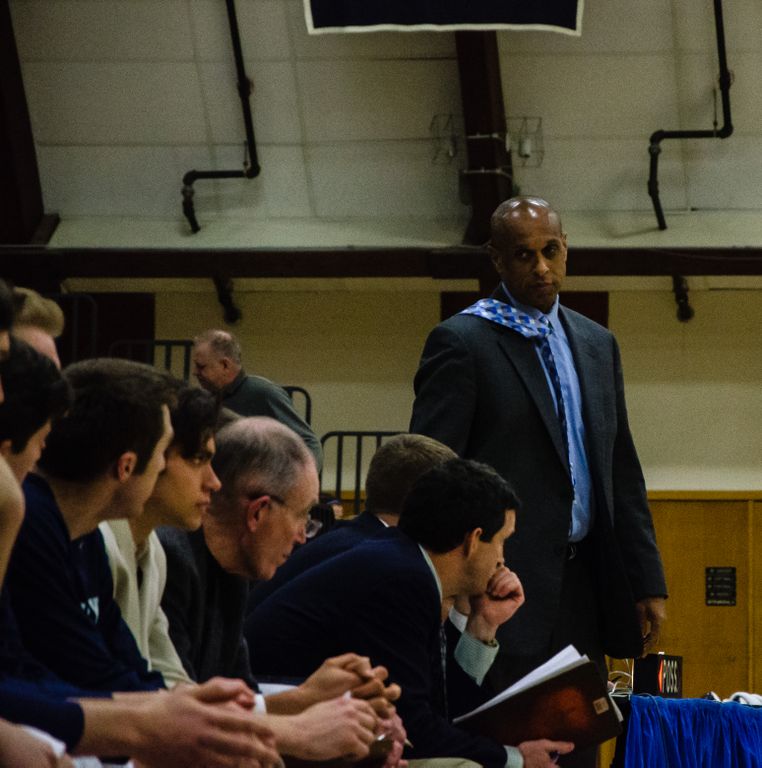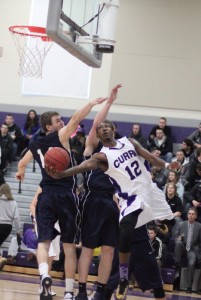 Middlebury plays in Cortland, New York at 3:00 pm Saturday. The Red Dragons (21-4) are undefeated on their home court (13-0) and have won all but one of those games by double-digits. Cortland relies heavily on the perimeter play of its guards, which as a collective group are among the best in the country. Four players have attempted at least 112 threes, and all of them shoot better than 38% from deep. As a team, Cortland shoots 38.9% from beyond the arc and 48.1% from the field. All 7 of the team’s top scorers from a season ago returned to the team this year, and five of the seven rotation players are seniors — an important factor for postseason play. Middlebury and Cortland faced two common opponents during the regular season: Ursinus and Plattsburgh State. Unfortunately, it’s hard to glean much from the results as Middlebury went 2-0 against the pair, winning close games on the road, while the Red Dragons comfortably beat Ursinus and Plattsburgh (twice) at home, but lost by 3 at Plattsburgh. Interestingly, while Cortland has shot the ball (and played) significantly better at home than on the road, it has nothing to do with their spacious gym, which holds 3,500 people, but has averaged just 380 fans per game. For context, Middlebury’s average attendance this season is 786, or 66% of Pepin’s capacity, compared to just 10.8% of Whitney T. Corey Gymnasium. Rabid fans or not, handing Cortland its first home loss of the season will be tough. Senior leadership and superior perimeter talent have carried the team to the most wins in program history. From our research and (limited) visual analysis, here are our first impressions of Cortland’s most significant players.
Middlebury plays in Cortland, New York at 3:00 pm Saturday. The Red Dragons (21-4) are undefeated on their home court (13-0) and have won all but one of those games by double-digits. Cortland relies heavily on the perimeter play of its guards, which as a collective group are among the best in the country. Four players have attempted at least 112 threes, and all of them shoot better than 38% from deep. As a team, Cortland shoots 38.9% from beyond the arc and 48.1% from the field. All 7 of the team’s top scorers from a season ago returned to the team this year, and five of the seven rotation players are seniors — an important factor for postseason play. Middlebury and Cortland faced two common opponents during the regular season: Ursinus and Plattsburgh State. Unfortunately, it’s hard to glean much from the results as Middlebury went 2-0 against the pair, winning close games on the road, while the Red Dragons comfortably beat Ursinus and Plattsburgh (twice) at home, but lost by 3 at Plattsburgh. Interestingly, while Cortland has shot the ball (and played) significantly better at home than on the road, it has nothing to do with their spacious gym, which holds 3,500 people, but has averaged just 380 fans per game. For context, Middlebury’s average attendance this season is 786, or 66% of Pepin’s capacity, compared to just 10.8% of Whitney T. Corey Gymnasium. Rabid fans or not, handing Cortland its first home loss of the season will be tough. Senior leadership and superior perimeter talent have carried the team to the most wins in program history. From our research and (limited) visual analysis, here are our first impressions of Cortland’s most significant players.
5’11” G Jesse Winter (15.1 ppg, 46 FG/39 3PT/82 FT): Winter is the leader of this Cortland offense. His offensive game reminds us of Aaron Toomey’s style of play. A dynamic scorer, Winter is most dangerous when he attacks the defense. From the heart of the floor he is a great distributor and a capable finisher. When defenses give help from the wings, he finds open looks for his teammates, and when they stay at home he continues at the basket, with the preponderance of plays ending either with a made basket or Winter at the line shooting free throws. Free throw shooting is an important element of Winter’s game. In 28 games this season, he has taken 131 free throws — 28 more than Joey Kizel, who leads the Panthers with 103 in 26 games. (For further context, Toomey has taken 120 free throws in 27 games.) Winter is an aggressive player in all facets of the game, including as a passer. He is intentional offensively, and looks to make plays in transition. To be successful the Panthers will have to slow him in transition, keep him out of the middle of the defense and stop him from going to the line. That sounds like a job for Nolan Thompson.
6’1” G Jeremy Smith (15.9 ppg, 45/43/85): Smith leads the Red Dragons in scoring and is the best three-point shooter on the team. While primarily a catch-and-shoot scorer, Smith has the quickness, athleticism and ball-handling ability to get into the lane and finish at the rim. He has impressive range and is a zone-breaker all by himself. Middlebury will have to choose the lesser of two evils when guarding Smith, and from what we’ve seen, that means playing him to shoot and challenging him to put the ball on the floor and beat his man with the dribble.
6’3” G/F Brian Manning (11.2 ppg, 44/40/81): Brian Manning is a scoring swingman who comes off the bench but plays starter minutes (26 mpg). In the last two years he has exemplified the sixth man role, scoring the third-most points on the team and shooting 46% from the field despite having never started a game. Manning thrives off the penetration of Winter and Smith, but can create on his own as well. He is a big key for Cortland because he spends a lot of time as the tallest of four guards on the floor when the Red Dragons go into four-guard sets, putting him in a lot of mismatches against opposing forwards. This helps him get open on the perimeter on offense, but should make him a target down low on defense.
6’6” F Kevin McMahon (12.6 ppg, 66/X/70): McMahon is quietly one of the more impressive big men Middlebury has faced all season, as he ranks second in the entire nation in field goal percentage. The senior has a bit of range but does most of his work around the basket, where his presence is also felt on the boards (7.5 rpg) and on defense (1.2 bpg). Very similar in build and stature to Peter Lynch, McMahon is not so much of a focal point of the offense as Lynch is for the Panthers, but he is as good of a complementary big man as it gets.
6’9” F Dan Sternkopf (2.1 ppg, 58/X/40): The senior center Sternkopf plays just 14 minutes per game despite starting. His 25 made field goals all season suggest a severely limited offensive game, but his 1.2 blocks per contest are quite impressive considering the playing time factor. We expect Sternkopf to be called upon to stop Jack Roberts and Peter Lynch at times, but whenever he is on offense, his man will be asked to roam because Sternkopf is a small enough threat to be left alone.
6’3” G Harrison Hefele (9.8 ppg, 49/38/60): Hefele is a versatile three-guard who can play inside and outside, making him a unique threat in this offense. He scores efficiently when called upon, and also puts up 4.7 rebounds, 2.4 assists, and 1.3 steals per game.
6’1” G Lamard Herron (7.6, ppg, 50/36/71): Herron is the lone underclassmen (sophomore) in the rotation, and his talent appears to warrant his playing time (22 mpg). Herron is first on the team in steals (1.9 spg), and is coming off of a 20 point performance in the first round win over Elms, shooting 8-10 from the floor and 2-3 from three.
Going through the matchups:
The difficulty of guarding Cortland State lies in their ability to play 4 guards on the court at once, all of whom can shoot the three. The two guys over 6’3” in the rotation—McMahon and Sternkopf—average 43 combined minutes per game, whereas the five other rotation mainstays average 139 combined minutes per game. Thus, 76% of minutes among Cortland’s expected big-game rotation go to guards, which means that if they stick to that rotation and timeshare, the Red Dragons will spend 32 minutes with four guards on the court. This is a unique challenge that few teams have been able to answer this season, because it is so rare to have four guys who can stop such a talented stable of guards, and who can maintain a high level of offensive play on the other end. The fact that McMahon, often the lone big man on the court, is so hard to stop makes the matchup even more challenging, but it is the guards who make this team especially dangerous.
Cortland may have an advantage on the outside, but in some ways this game feels designed to the strengths of Peter Lynch and, in particular, James Jensen. While four-guard sets have undoubtedly given other teams matchup problems, Cortland’s offensive design appears to play right into the defensive teeth of the Panthers. Jensen’s versatility on defense and his explosiveness and leaping ability on offense will negate some of what Cortland can do with that fourth guard. Jensen has guarded point guards and shooters before this season, so Cortland will not be able to take advantage of a big mismatch like they so often do. On offense, Jensen will almost certainly have a 3-inch height advantage on his man in these situations, and the Panthers will look inside to him to score down low. Jensen’s value lies in his versatility; in a game like this, if he steps up to the opportunity, he could play 30+ minutes. Next to him down low for much of the game will be Peter Lynch, who has been tremendous against smaller defensive lineups, torching teams consistently all season that haven’t been able to keep him out of the lane. McMahon will have a hard time slowing down Lynch in the post, and as long as he stays out of foul trouble, Lynch should be a big part of Middlebury’s offensive success. With Jensen on the fourth guard and Lynch on McMahon, Jack Roberts will likely mirror Sternkopf’s minutes and also spell Lynch for stretches. The playing time of Middlebury’s fourth forward, Hunter Merryman, depends on whether the coaches believe he can stick with any of the guards on defense. If he can, Merryman should feast on the mismatches on the other end.
While Middlebury’s frontcourt has much to look forward to in this matchup, the backcourt is playing the underdog role in their positional matchup, as the Cortland guards will be very tough to slow down. It all starts with Winter, and for that reason, we expect Nolan Thompson to start the game on the 5’11” senior. The main objective with Winter is to prevent his dribble penetration, because the Red Dragon offense is predicated on the open looks Winter can find once he draws help. If Thompson keeps Winter on the perimeter, the next challenge for Middlebury will be sticking with the guards through extended offensive sets. Winter, Smith, and co. are great and quick passers, and their off the ball movement creates a lot of open threes. This style of play demands discipline and heady play from Middlebury’s guards. Finally, Kizel and Wolfin will have to keep their guards in front of them with the ball in their hands. We can foresee a scenario where Smith steps into Winter’s drive-and-kick role if Thompson guards Winter. The other challenge that the Cortland guards present is the fastbreak, where their passing, vision, and quickness are on full display. Kizel, Wolfin, and Thompson must be aware of this threat and play safety for the defense to force Cortland into the halfcourt offense.
Forecast:
Cortland State is the best non-conference opponent Middlebury has faced in the last two seasons. Their guards have been too much to handle for pretty much every team they have faced thus far, and if they get out in the fastbreak or get hot from three, there are few teams who can stick with them, especially on their home court. Given the fact that Middlebury has been unable to put together many near-40 minute performances this season, we expect the Cortland runs to be especially difficult to sustain. These factors help account for the fact that the well-respected Massey Ratings system gives Cortland State a 79% chance to win this game. Middlebury’s season is on the ropes. In my view, the Cortland guards will be too much to handle and they will pull away with stretches of near-unstoppable offense, while Middlebury’s problems with consistency will remain. In Damon’s view, Thompson will force their offense out of its rhythm, and the Jensen and Lynch factors will carry Middlebury to victory.

